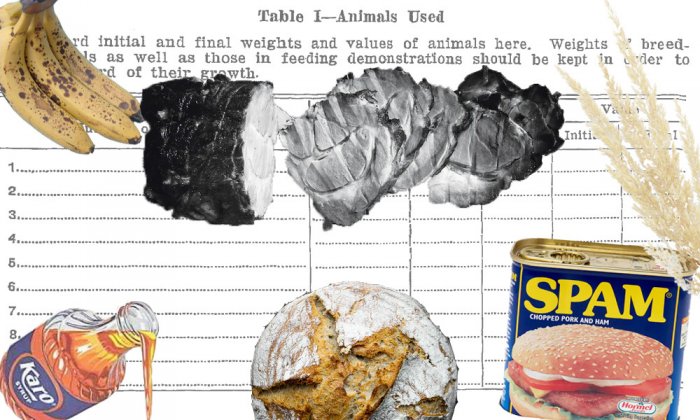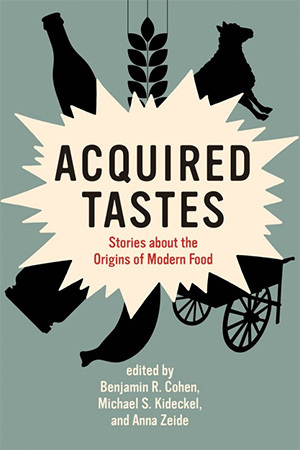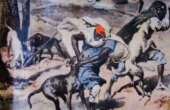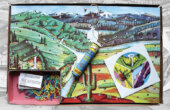The Hidden Lives of Modern Food

Many food writers trace our modern way of eating — our taste for food that is processed, packaged, and mass-marketed — to World War II. In truth, argue Anna Zeide, Ben Cohen, and Michael Kideckel, the editors of a new collection of essays on the oft-overlooked history of modern food, the World War II era was more of an intensification than a starting point.

By this period, they write, “food in much of the United States and Europe bore the collective imprint of global trade, colonization, mass distribution, racist science, celebrity culture, and factory processing.” Remarkably, a century earlier, it did not. So how did we arrive at the food system we all recognize today? How did our common misconceptions about food history arise? And why does the narrative about how we got here matter?
In the following interview, Zeide, Cohen, and Kideckel respond to these questions, explain how the pandemic exposed fissures in our food supply chain, and argue that we’ve only begun to scratch the surface of a food system whose depths demand greater scrutiny. Their new book, “Acquired Tastes,” takes readers through a series of moments in food history — stories of bread, beer, sugar, canned food, fake meat, and more — tracing nutritional reform through its thorny history and introducing critical considerations to forge a future that is healthier for the land, our bodies, and our cultural relationships.
Zoë Kopp-Weber: Many popular food writers trace our eating habits to WWII, but as you emphasize in “Acquired Tastes,” our current food system began to coalesce as early as the 1870s. Why is the narrative about our modern way of eating problematic? And how does it hinder us when considering the future of food?
Benjamin R. Cohen, Anna Zeide, Michael S. Kideckel: Writers, activists, and politicians often use history as a rhetorical device, a hook to convince their audience that our current problems began in some foggy moment after the Good Times. But using history in that way, without a thoughtful attention to detail, leaves society less able to untangle what caused the issues we want to solve. Writers point to World War II as the beginning of modern food and agriculture. But World War II didn’t mark a starting point so much as a speeding up of what came before.
Looking to the War as some huge pivot point obscures older, more entrenched traditions and institutions that shaped modern food. As so many of the essays in our collection show, central qualities of food in the United States — its globalized, scientific, marketed, racialized nature — took form in the decades around 1900. The context of 1900 differs significantly from 1945. We need to understand that people in the early part of the 20th century believed in technology, government, eugenics, and large corporations in a way that differed from what folks after the Second World War thought. Only by knowing the specifics of that context, of the food system’s origins, can we assess how current practices differ from what came earlier. Only by knowing specifics can we see what possibilities we may have available to us as we search for solutions.
Put another way, if we in the 21st century want to work for a decolonized, racially just food system, it won’t help much to center those efforts on surface features that have grown in the past 75 years on top of deeper capitalist market structures built in the 75 years before that. Industrialists, scientists, and government workers built those deeper structures on models of global extraction, consumer dependence, and colonial assumptions about who gets to decide which foods we eat. The newer superficial features like, say, labels or brands or new super foods and vitamin supplements tinker with how those models look, but they don’t move us beyond the idea that a handful of people in positions of institutional authority should make large-scale decisions about how people eat.
ZKW: What are some common misconceptions of modern food and food history that you sought to confront in editing the book?
The Authors: The main misconceptions we tried to target come mostly from popular food histories, up to and including the great explosion in food media on television and in print over the past generation. These have spread the idea that the most relevant events in creating modern food happened in the years following World War II. Works that provide that image tend to tackle individual consumption habits as the main problem. In “Acquired Tastes,” we sought to illuminate that the big issues are political and thus need policy solutions.
Too much popular food writing focuses the lens on individual actions and choices. We learn to shop at farmers’ markets and change our diet to eat Impossible burgers. That helps, and we need those solutions, but a focus on individual responses leads readers to miss the structural forces that overwhelm such individualist approaches. Government subsidies, for example, along with corporate forces, agrochemical firms, global trade deals, and negotiations at large political scales about labor, wages, and land use pull our decisions as consumers back into the prevailing ways food and agriculture exist in the world. Personal shopping choices don’t change the structures, the pieces of which powerful people have been building into the world for over a century.
Many of our essays get at this question of systems and food. Faron Levesque writes about what we now call food justice, a concept that has received meaningful scholarly attention in our century, but one that names a feature of food systems that goes back at least to the Gilded Age and Jim Crow. Lisa Haushofer shows us the links between extract-based nutrition and imperial ambitions. Alex Orquiza connects colonial assumptions about who had “cuisine” with which people’s cooking show up more prominently in the American restaurant scene today.
As so many of our colleagues and mentors have shown, food is political in history too, not just now. It’s hard enough to make the point to a lot of foodies today that food is political always, everywhere, and is never just about food. But then add on that that’s also been the case throughout history, and it becomes even more difficult for a lot of folks to hold onto. The always-political, always-contested nature of food systems isn’t a new phenomenon that people have stumbled upon in the 21st century. The stories in this collection point out that decisions about food and farming have always been decisions about how to structure the world. We should talk about how people choose to structure the world more often when we tell stories about food, not just which new product tastes great or how quickly someone can deliver it to us.
The always-political, always-contested nature of food systems isn’t a new phenomenon that people have stumbled upon in the 21st century.
ZKW: You all worked on this book during the summer of 2020 when the pandemic laid bare a number of problems in our current food systems, labor, and operations. What are your greatest concerns as the globe tries to regroup and recover from the past year?
The Authors: As we write in the Epilogue, so many of the predicted consequences of the food system came to pass in the Covid-19 pandemic. Though scientists still debate the origins of this virus, its nature as a zoonotic disease — one that moves from non-human animal populations into human ones — points to how unsustainable the animal agriculture system truly is. The ways in which we have confined and concentrated animals to provide us cheap meat create and spread devastating diseases. And, of course, those who labor in the food system — on agricultural fields, in meatpacking plants, in food processing factories, as grocery store employees, or as food delivery workers — feel the negative effects of that system most acutely. In contrast, the ways that so many wealthy Americans quickly pivoted to ordering their groceries and restaurant take-out meals for delivery, or spending their newfound “leisure time” baking sourdough bread or growing herbs, further highlight the deep inequalities in American society.
The fissures in our food supply chains that were clear early in the pandemic perhaps opened space to make some of these dramatic disparities visible, to make privileged Americans more aware of the behind-the-scenes labor that makes our abundant food supply available, safe, and cheap. But we fear that those discoveries have been buried once more, leaving the divide even more entrenched. The outpouring of support for doctors and other healthcare workers has been important and well-deserved. But you don’t see as many signs around for the front-line workers who also sustain our lives in dangerous, and far more poorly compensated, ways.
Some of this might reflect our cure-things approach to healthcare: We appreciate doctors and vaccine companies because they solve problems. But that idea of creating, or allowing, major problems and then making money by solving them aligns with the rushed, exploitative, modern approach we discuss in the book. What if, instead, we could prevent those problems to begin with? The modern food system has, like modern medicine, solved some incredible problems. And obviously many threats to human health predate both modern food and modern medicine. But some of those problems are features of a modern system dating, again, to the decades well before the mid-20th century. Understanding food in its historical context allows us to think about prevention rather than merely reactions.
ZKW: How did you determine which stories and moments in food history you wanted to highlight in the book? Can you talk a bit about the significance of some of those histories? Were there any stories that for whatever reason didn’t make the cut but you wish were included?
The Authors: We began with a vision of bringing together a wide range of stories that focused on the period between the 1870s and the 1930s. We solicited proposals from historians doing two things: one, working at the intersection of food and environment and, two, seeking to work as writers for audiences beyond academic confines. As the essays took shape, we considered how to organize these varied stories into a series of themes that cohered. In order to help readers connect the dots, we developed the categories of “time and space,” “trust,” and “science” as the three parts of the book. There are lots of other ways these stories could have been organized, but these three themes emphasize some of the broad trends of the period.
The stories in “time and space” show the ways people built global connections that brought food to different people, but at the cost of autonomy, environmental health, and what we now talk about as equity and inclusion. Stitching together wheat in former lake lands of Southern California to the working class of England, as Tom Finger’s essay shows, required genocidal warfare against the Yokuts and environmental destruction of previously fertile ecosystems. Or, in a less violent story, Tom Okie tells us how we came to manage death over time as a core element of modern distributed food, through a story of supply chains, handcarts, and new urban food environments. Those and a few others offer highlights about how and why a global marketplace came into being and at what costs.
In the section on “trust,” contributors tell stories about fake sugar, breakfast cereal, radical food stores, bananas, and canned food. Collectively, they offer snapshots of contests over authority, moral and otherwise, amid changing relationships between producers and consumers — relationships that were changing in great part because of the collapse of space and time covered in Part I.
We ended up with a number of contributors who had expertise in the history of science too and so our third part revolves around science. The stories there show how Americans navigating new physical and moral relationships came to trust institutional expertise — people with degrees, certifications, and the backing of major authorities. That new institutional expertise still structures much of the debate around food systems today. The book has a story about sugar imports, one on this weird thing called “fluid meat,” another on the science of fake meat from the early 1900s, and a final one about a girl named Marietta and her lamb in the 4H, and how Marietta learned to be a scientific feeder and a scientific eater.
There were a lot of stories we wish we could have included. Modern food consists of many narratives that we have only begun to tell. Food scholars have put a great array of places and cultures in the spotlight. We worked hard to make this collection diverse, but there’s always room to include more perspectives. Even as we believe that this collection offers a great deal of nuance and depth to the historical context, we remain acutely aware of its shortcomings. And as three white editors, we get that we have certainly missed things in what we put together. Our hope is to offer a way of thinking and writing about modern food that we find useful; we’d love to have a future collection that continued that conversation with more voices.
Understanding food in its historical context allows us to think about prevention rather than merely reactions.
ZKW: You emphasize that the stories in your book are especially urgent given the twinned crises of climate change and the injustice and inequity plaguing the food system. With this in mind, what do you hope readers take away from the book?
The Authors: We hope readers find that those twinned crises demand that we think beyond some long-held assumptions in American and European food policy. Our approach to the future of food cannot focus just on things like crop choices, consumer options, or tech-sector delivery apps (though those will also play a part). We need to be working on market structures, questions of racial justice, and decolonization in the food system. Those are not easy to address, they feel huge for a reader at home, but we want readers to come away from this collection at least seeing that attempts at addressing them must contend with their deep foundations. We want to help readers feel they have some background from which to work on responsible food reform.
Granted, we worry about that. We write in the epilogue of a continued trend toward making individual homes the clearinghouse of culinary commerce for those who can afford it, toward validating trust in brand names and the invisibility of human laborers, toward equating safety with science. All of this reflects the foundations that were laid in the period described in the book.
But here’s the thing. We push back on the use of history to say “what’s now is bad; what came before must be good.” Of course, people developing the modern food system reacted to the world around them and offered their views of solutions in their own time. And those have problems. And what came before had problems too. But, when change seems impossible and life seems big, history does offer a crucial lesson: Things have changed before, so they can change again. Without falling into a trap of nostalgia, much that successful capitalists wiped out does offer promising solutions for the future: different structures of decision-making, Indigenous land-use and knowledge, acceptance of diversity, not only in terms of multiculturalism but also by recognizing that what even progressives take as neutral scientific standards often reflect cultural biases. The past was not necessarily better, but much that happened in the past was. Turning to context illuminates what has changed, and what can — and must — change again.
Benjamin R. Cohen, Michael S. Kideckel, and Anna Zeide are the editors of “Acquired Tastes: Stories about the Origins of Modern Food.”
Zoë Kopp-Weber is a publicity associate at the MIT Press.



